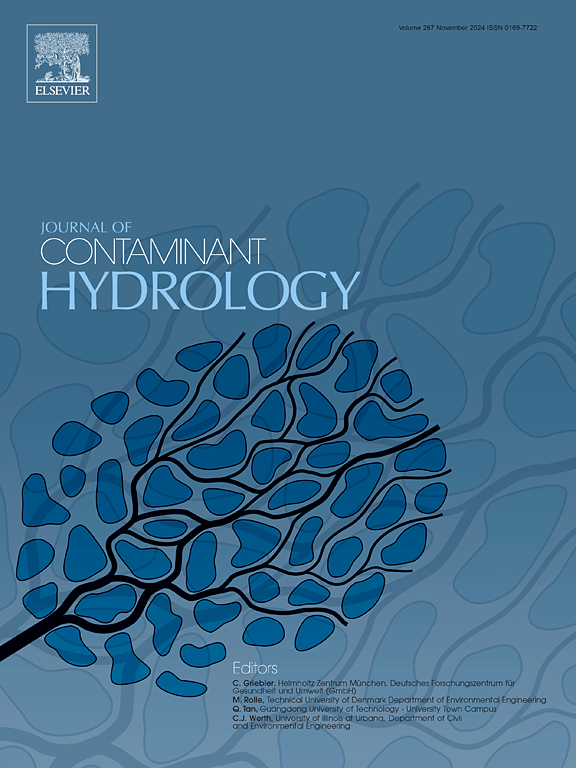Experimental and numerical studies on fluid flow through fractured rock masses based on an enhanced three-dimensional discrete fracture network model
IF 3.5
3区 环境科学与生态学
Q2 ENVIRONMENTAL SCIENCES
引用次数: 0
Abstract
Fluid flow through rock fracture networks was experimentally and numerically studied based on an enhanced discrete fracture network (DFN) model that explicitly characterizes 3D void geometry within rough-walled fracture. Fluid flow tests under different hydraulic gradients J were conducted on a series of DFN samples created by a 3D printer. Meanwhile, numerical simulations were performed based on the enhanced DFN model solving the NS equations and conventional DFN model solving the Reynolds equation, respectively. The validity of the simulations was verified by comparison with flow tests. Then numerical investigations were extended to amend the permeability estimated by the Reynolds equation to seek for an acceptable approximation to the calculation of the Navier–Stokes (NS) equations. The results indicate that the enhanced DFN model can better capture the nonlinear flow caused by surface roughness and aperture heterogeneity, providing more realistic fracture representation and more accurate results. The conventional DFN model overestimates permeability by up to 82 % compared to the flow test result, while the enhanced DFN model give more accurate permeability with a fewer error of 5.3 %. As the fracture number or surface roughness increases, the critical hydraulic gradient Jc that defines the onset of the nonlinear flow decreases. For the linear flow regime under J < Jc, a model that can directly compare the equivalent permeability estimated by NS equations and Reynolds equation was proposed. This is important for assessment of permeability of fracture media where the conventional DFN model solving Reynolds equation is primarily utilized to reduce computational burden.
基于增强三维离散裂隙网络模型的裂隙岩体流体流动实验与数值研究
基于增强的离散裂缝网络(DFN)模型,对岩石裂缝网络中的流体流动进行了实验和数值研究,该模型明确表征了粗壁裂缝内的三维空隙几何形状。利用3D打印机制作了一系列DFN样品,进行了不同水力梯度J下的流体流动试验。同时,分别采用求解NS方程的增强型DFN模型和求解Reynolds方程的传统DFN模型进行了数值模拟。通过与流动试验的对比,验证了模拟的有效性。然后将数值研究扩展到修正由Reynolds方程估计的渗透率,以寻求一个可接受的近似于Navier-Stokes (NS)方程的计算。结果表明,改进后的DFN模型可以更好地捕捉由表面粗糙度和孔径非均质性引起的非线性流动,提供更真实的裂缝表示和更准确的结果。与流动测试结果相比,传统DFN模型对渗透率的高估高达82%,而增强DFN模型给出的渗透率更准确,误差更小,仅为5.3%。随着裂缝数或表面粗糙度的增加,定义非线性流动开始的临界水力梯度Jc减小。对于J <作用下的线性流态;提出了一种可以直接比较NS方程和Reynolds方程估算的等效渗透率的模型。这对于裂缝介质渗透率的评估具有重要意义,因为传统的DFN模型主要是通过求解Reynolds方程来减少计算量。
本文章由计算机程序翻译,如有差异,请以英文原文为准。
求助全文
约1分钟内获得全文
求助全文
来源期刊

Journal of contaminant hydrology
环境科学-地球科学综合
CiteScore
6.80
自引率
2.80%
发文量
129
审稿时长
68 days
期刊介绍:
The Journal of Contaminant Hydrology is an international journal publishing scientific articles pertaining to the contamination of subsurface water resources. Emphasis is placed on investigations of the physical, chemical, and biological processes influencing the behavior and fate of organic and inorganic contaminants in the unsaturated (vadose) and saturated (groundwater) zones, as well as at groundwater-surface water interfaces. The ecological impacts of contaminants transported both from and to aquifers are of interest. Articles on contamination of surface water only, without a link to groundwater, are out of the scope. Broad latitude is allowed in identifying contaminants of interest, and include legacy and emerging pollutants, nutrients, nanoparticles, pathogenic microorganisms (e.g., bacteria, viruses, protozoa), microplastics, and various constituents associated with energy production (e.g., methane, carbon dioxide, hydrogen sulfide).
The journal''s scope embraces a wide range of topics including: experimental investigations of contaminant sorption, diffusion, transformation, volatilization and transport in the surface and subsurface; characterization of soil and aquifer properties only as they influence contaminant behavior; development and testing of mathematical models of contaminant behaviour; innovative techniques for restoration of contaminated sites; development of new tools or techniques for monitoring the extent of soil and groundwater contamination; transformation of contaminants in the hyporheic zone; effects of contaminants traversing the hyporheic zone on surface water and groundwater ecosystems; subsurface carbon sequestration and/or turnover; and migration of fluids associated with energy production into groundwater.
 求助内容:
求助内容: 应助结果提醒方式:
应助结果提醒方式:


